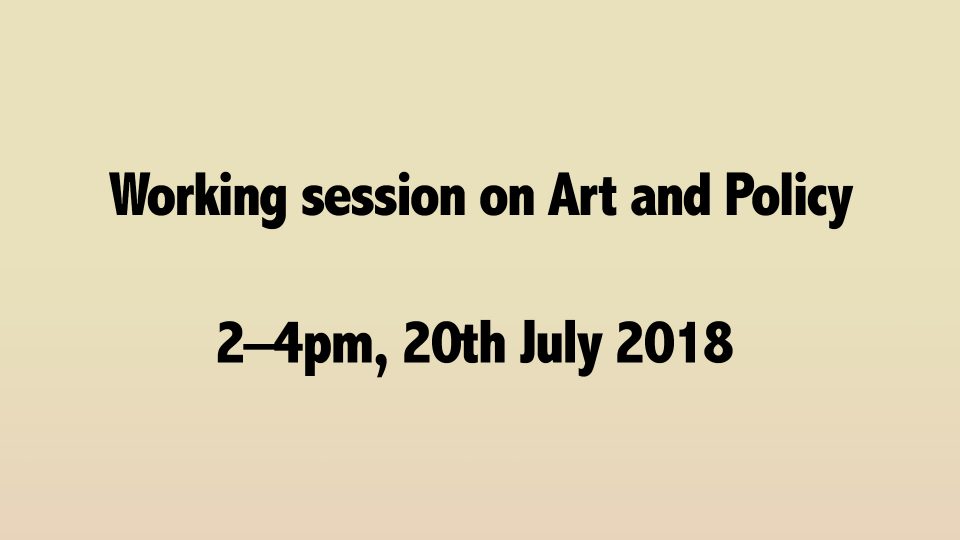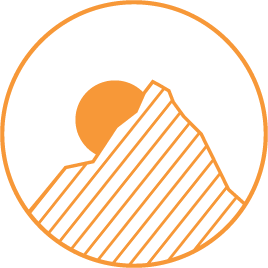Installation #22/23 - Tom Clark - Policy, Intervention and Art

Tom Clark
Policy, Intervention and Art
Installation #22/23 - 20 July 2018
Participants
- Tom Clark - Workshop Convener (Goldsmiths, Dept. Art)
- Susannah Haslam (RCA / Independent researcher)
- Lucy Lopez (BCU / Eastside Projects / Grand Union)
- Claire Louise Staunton (RCA)
- Edgar Schmitz (Goldsmiths, Dept. Art)
What have art and policy to do with one another?
Policy is the instruction book for how the image of the institution is brought into being; policy defines the conditions of participation and the parameters of its function.
Policy pronounces some as incorrect.
Policy says what we will do with what have.
Policy makes aspirations the edges of its reality.
Policy operates at scales ranging from the massive to the intimate, jointing them.
It functions like an infrastructure.
Aims
In this workshop on art and policy I wanted to explore some of the preliminary as well as more sustained experiences, difficulties and commonalities of in working between art and policy, policy and art, and policy for art. How can we understand the scales of interaction between policy and art? Could policy be treated as an object, a site, a mechanism and also a specific context? As something that can be worked on in a more active mode than through representation and negation through critique?
Already there are some examples of this coming together,
- Policy People, a group based in the Netherlands who has sought to bring the question of policy making into the critical field of art and design. (http://policy-people.com/; see especially, cultural critic Egbert Alejandro Martina (https://processedlives.wordpress.com/) on Policy and Intimacy http://policy-people.com/egbert-alejandro-martina-policy-and-intimacy/)
- Medium Design, an ebook by Keller Easterling, who argues for an engagement in the infrastructures of culture, not simply acts of naming. (http://kellereasterling.com/articles/medium-design-strelka)
- The Undercommons, Stefano Harney and Fred Moten’s book offers a wide-ranging critique of policy as tool of domination. (http://www.minorcompositions.info/wp-content/uploads/2013/04/undercommons-web.pdf)
- A.G.E., a group in New York who advocate for Artist’s getting paid equitably, setting up a system of certification. (https://wageforwork.com/home#top)
- The People’s Cultural Plan, again in New York, a counter-policy by artists and community organizers, which offered a counter policy for cultural spending to the official one. (https://www.peoplesculturalplan.org/)
- The “Making Cultural Infrastructure” report by Theatrum Mundi, developed as a policy proposal on the necessary investment and building of cultural infrastructure in response to the Mayor of London’s planned Creative Enterprise Zones call in 2017. (http://theatrum-mundi.org/project/culturalinfrastructure/)
- “Policy Show,” curated by Lucy Lopez and Gavin Wade at Eastside Projects in Birmingham, which sought to explore how policies developed in and for an arts organization might model policies for more a general public sphere. (https://eastsideprojects.org/projects/policy-show/)
In this workshop then, I hoped to extend these existing examples, and draw upon the invited participants’ diverse work, which in one way or another intersected policy as object, site, or its results. (Lucy has co-curated Policy Show at Eastside Projects in Birmingham and whose research covers the possibility of institutional care; Susannah, who researches models of education in the arts and worked on local arts policy planning; Claire who is researching the possibility of artistic and curatorial interventions into housing policy and schemes; and Edgar whose work concerns the choreographic, organizational practices of infrastructural and institutional forms.)
While we each had a relationship to art that would ground this conversation, I was also keen that this session would also allow us to push the specific question of artistic intervention more generally. Where art might provide some space or methods for intervention into the objects and practice of policy. Or how we might discuss how art responds to the changing conditions of possibility shaping artistic production and display as define by current policies (from a variety of sources). Exploring how these might have changed to the extent that intervention into these conditions is considered urgent and necessary.
In the context of my research, this workshop was also conceived in order test out what I am calling an “infrastructural” dimension of practice, audience, site and so on. Here models rather than representations, approaches that are systemic, interoperable, reproductive, communicative, tacit, etc., are developed with and in distinction to purely artistic work. Similarly, this mapping workshop sought — among other things — to ask, if the question of strategic policy-making done outside of government has in many cases been taken up as a design problem: what happens when the same is done in practices of art? Not only seeking to provoke some of the habits of the arts with the solutions-oriented outlook of design, this was also an attempt to explore what policy-related practices could be already said to be immanent to the arts.
However, if one of the problems of this infrastructural approach is getting bogged down in describing all of the objects, processes and rules that are captured in the orbit of the term “infrastructure,” looking at policy is an attempt to draw the edges of infrastructure through traces of its actions. In this case, it specifically included attempted to discuss the non-physical infrastructures that condition the field of art. Could policy be described, like infrastructure as scalable or situated — a form that can be cracked open to think about and change the repetition and reproduction of conditions and distribution of the possible?
Returning to the question of intervention, this was also an opportunity to flesh out an idea of infrastructural and institutional actors: who are these? What do they do in these terms? And if infrastructure is not simply a set of objects, but organizational principles and imaginaries: to what extent does an infrastructural lens necessitate an intervention or creation of forms through which to give body and conditions to see and therefore work on infrastructure in the first place?
Of course this was also posing the question of policy as a problem. As Edgar Schmitz put it, paraphrasing Irit Rogoff, the question could also be asked like this: “Why are we suddenly employing the terms which we are usually vehemently against; tool of the ‘others’.” As many have made clear, including Fred Moten and Stefano Harney in The Undercommons, the problem of policy precedes its entry into the discourse of art. Not to mention that it might already be considered as an urgent problem.
Policy is also defined in this sense by shaping the very possibilities of life through how it differentiates life. Important for this discussion was the grinding continuity to policy — like many other things — that does not sit easily with institutional disposition towards evacuating the contingency and possibility of various subjects as the institution (of art) re-thinks itself. The problem of policy cannot be solved by its incorporation into and purification through a discourse of critique; nor can this be done through the movement away from one institutional shape or space into another. This was also why to think of policy in infrastructural terms, of reproduction and repetition, opens out to the Moten and Harney’s depiction of policy as the continuous capture of contingency, risk and flexibility; and to perhaps rejecting a sense that moving into another space means we can leave behind what is with us now.
It must be said then, that to focus on policy as a space which comprises the conditions of production and thus as one in which it might be possible to intervene was not necessarily to affirm it, but to put it forward as a possible surface of artistic work, making and use. Since this workshop aimed, at minimum, to understand where the question of policy currently sits in the arts, this conversation sought more than anything to articulate a starting point. This, it was hoped, would allow us to deal with the frustrations, differing scales, locations and arms-length operations of actual policy-making.
This was essentially a closed working session, which included participants discussing work in formation, and so I can only summarize what we said. However, some of the key questions to take forward included:
- Does the infrastructural / organizational turn have to do with how power exceeds the institution; the effects and how this read has changed, surfaced differently, consistently?
- This could be located by the question of how users of infrastructures differ to citizens or audience members, where policy sets conditions of appearance, not simply engagement.
- The discussion drew on histories APG; feminist organising; housing struggles — which all exceeded the institution, and the participant’s research into them.
- How can arts organizations navigate their own scale and problems through policy; seeing moments of disruption as moments in which to consider how they will act in the future.
- Whether a focus on policy is focused inwards or outwards.
- The challenges of generalizing policy in a space of individual and collective practice, power and agency such as in the arts.
- How artists have historically attempted to navigate these dynamics, specifically in relation to housing policy, working as or with policy makers, and how artists might be instrumentalized in the process of implementing policy — whether creating the sense of democratization in decision-making, or easing structural transformation or gentrification.
- How artists and artistic practice might be better placed to resist policy than to engage with it as a productive site. How curatorial and arts-organizational methods might learn something from this.
- We questioned to what extent this focus on policy represented a methodological shift or just a form of house-keeping of ideas on forms of domination.
- Does this represent an over-identification with bureaucracy, as has already been practiced in art?
- Could policy be re-positioned within the scope of language games.
- As a material contract; a language performance; a linguistic object?
- Is this the curse of art: to frame it as such?
- Or can we see this as a practice of finding access points to that which is usually kept at bay?
- Is this question even appropriate within the arts? Is it a mis-identificaiton or over-identification? An attempt to distort?
- How might we frame this as part of a Participatory Turn or so-called ‘Consultational’ Turn? What sort of expertise does this presume and deploy? — Is this even what an artist should be asked to do?
- What competencies we perform as artists; Can we weaponise competency; following the post-autonomist models of subsumptions; reproducing the possibilities of neoliberal conditions; how can we weaponise this differently?
- If policy is at odds with the terms of planning, as posed in The Undercommons, what else can be done with the performativity of this language?
- Make it shimmer?
- Con-figuration as the creation of partial objects and subjects? (Suchman)
- Modelling is the necessary fiction that permits an intervention into infrastructure; to what extent should these models be formalised?
- How does this work in the context of institutions of power?
Tom Clark's work focuses on art, curating and its politics, specifically the questions of instituting and publishing (making public); art produced after networks; a history of the narratives, forms, materiality and politics of affect collectivity and history in contemporary art practices; and questions of value, publics and collectivity in art and its organisation.

